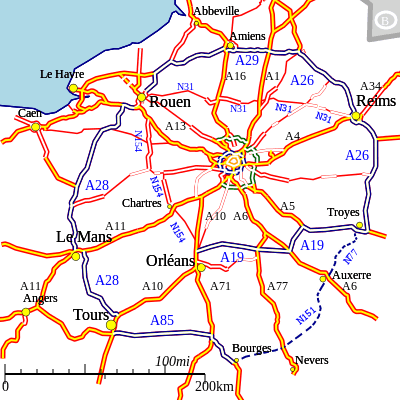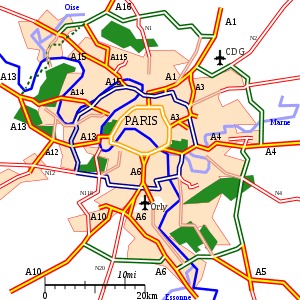Autoroutes of France
The autoroute (French: [otoʁut] (![]()
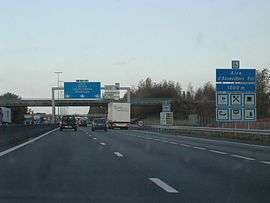
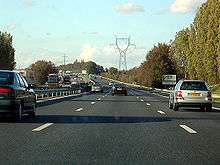
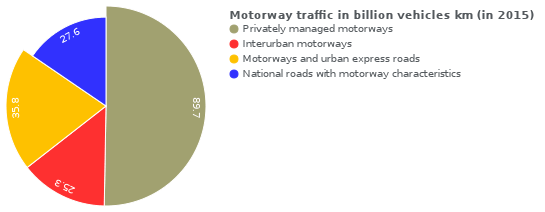 |
| Source Observatoire national interministériel de la sécurité routière.[1] |
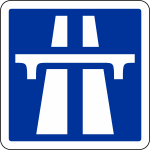
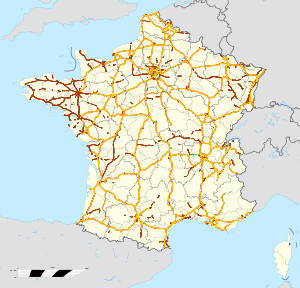
Length
| Network length (Privately managed & national statistics) | |
|---|---|
 | |
| Source ASFA.[2], ASFA 2018[3]; Eurostat (road_if_motorwa serie) | |
Numbering scheme
Unlike other motorway systems, there is no systematic numbering system, but there is a clustering of Autoroute numbers based on region.
A1, A3, A4, A5, A6, A10, A13, A14, A15, A16 radiate clockwise from Paris with A2, A11, and A12 branching from A1, A10, and A13, respectively. A7 begins in Lyon, where A6 ends. A8 and A9 begin from the A7.
The 20s are found in northern France. The 30s are found in eastern France. The 40s are found near the Alps. The 50s are in the southeast, near the French Riviera. The 60s are found in southern France. The 70s are found in the centre of the country. The 80s are found in western France.
Named routes
Some of the autoroutes are often given a name, even if these are not very used:
- A1 is the autoroute du Nord (Northern motorway).
- A4 is the autoroute de l'Est (Eastern motorway).
- A6 and A7 are autoroutes du Soleil (Motorways of the Sun), as it leads from northern to southern France and its sunny beach resorts.
- A8 is named La provençale as it cross the geographical region of Provence.
- A9 is named La Languedocienne as it crosses the geographical region of Languedoc
- A10 is named L'Aquitaine because it leads to Bordeaux, which is situated in the region Nouvelle-Aquitaine.
- A11 is named L'Oceane because it leads to Atlantic Ocean (Nantes)
- A13 is named the autoroute de Normandie as it traverses the region Normandy.
- A16 is named L'Européenne (the European) because it connects the French capital city with the Belgium–France border, passing by Calais, which is connected with England.
- A20 is named L'occitane as it leads to the south-west of France, in the region Occitanie.
- A21 is named the rocade minière (mining road) because it crosses de Nord-Pas de Calais Mining Basin, the biggest mining stub in France.
- A26 is named the autoroute des Anglais (motorway of the English) as it leads from Calais, the main point of arrival for cars and lorries from the UK. It continues to Troyes, and passes straight through the Champagne region, whose wines are loved by the British. In addition it passes near the sites of the most famous battles fought by the British Army in World War I, such as Arras, Cambrai and the Somme and not far from Ypres and Mons in Belgium. It also passes sites of earlier UK interest such as Crecy and The Field of the Cloth of Gold.
- A36 is called la Comtoise after the region Franche Comté
- A40 is named the autoroute blanche (white motorway) because it is the road that goes the Alps and French winter resort towns.
- The A61 and A62 are named autoroute des deux mers (the two seas motorway) because these roads connect the Atlantic Ocean and the Mediterranean Sea from Bordeaux via Toulouse to Narbonne.
- A68 is called autoroute du Pastel because it leads to Albi and to the Lauragais where woad was cultivated to produce pastel.
- A71 is called L'Arverne.
- A75 is called La Méridienne.
- A77 is called Autoroute de l'Arbre.
- A84 is called Autoroute des Estuaires because it is part of the main route between Belgium and Spain, avoiding Paris.
- A104, one of Paris's beltways, is also known as La Francilienne because it circles the region of Ile-de-France.
Administration
The status of motorways in France has been the subject of debate through years, from their construction until recently. Originally, the autoroutes were built by private companies mandated by the French government and followed strict construction rules as described below. They are operated and maintained by mixed companies held in part by private interests and in part by the state. Those companies hold concessions, which means that autoroutes belong to the French state and their administration to semi-private companies. Vinci controls around 4,380 km (2,720 mi) of motorway. The different companies are as follows:
- ALIS (SEM, SAPN 8%, Bouygues 20.2%, Ixis 26%, DTP Terrassement 13.44%), concessionnaire de l'A28 Rouen-Alençon 125 km, Alis, official site
- SAPRR (Autoroutes Paris-Rhin-Rhône), 1801 km, SAPRR, official site
- AREA (Société des Autoroutes Rhône-Alpes, SAPRR Subsidiary at 99.82%), 381 km, AREA, official site
- ASF (Autoroutes du sud de la France), 2325 km, ASF, official site (bought by vinci-autoroutes.com Vinci)
- ATMB Autoroutes et tunnels du Mont-Blanc, 107 km, ATMB, official site
- CEVM (Viaduc de Millau, groupe Eiffage), 2.5 km, CEVM, official site
- Cofiroute (Compagnie Industrielle et Financière des Autoroutes, private company part of Vinci group), 896 km, Cofiroute, official site
- Escota (Société des Autoroutes Esterel-Côte d'Azur, ASF group), 460 km, Escota, official site (bought by vinci-autoroutes.com Vinci)
- Sanef (Société des autoroutes du Nord et de l'Est de la France), A.C.S. group (Spain), 1317 km, SANEF, official site
- SAPN (Société des autoroutes Paris-Normandie, SEM, groupe Sanef), 366 km, SAPN, official site
- SFTRF, Société française du tunnel routier du Fréjus, 67 km, SFRTF, official site
Only in the Brittany region do most of the autoroutes belong to the government. They are operated by the regional council and are free from tolls.
| Privately managed | |
|---|---|
 |
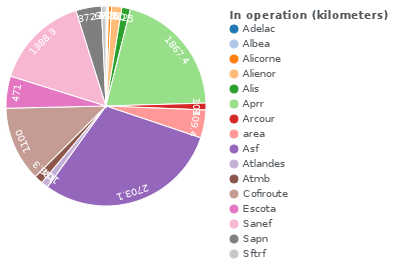 |
| Source ASFA[2] | |
Safety on French autoroutes
Safe driving
France has the following speed limits for limited access roads classified as motorways:
- Under normal conditions - 130 km/h (80 mph)
- In rain or wet road conditions - 110 km/h (70 mph)
- In heavy fog or snowy/icy conditions - 50 km/h (30 mph)
Limited access roads classified as express roads have lower speed limit (90 or 110 km/h, 55 or 70 mph).
In normal conditions, there is a minimum speed of 80 km/h (50 mph) in the lane most left (no minimum speed on the others' right lanes, but speed should be adapted for each situation: not too slow).
Safe design
The autoroutes are designed to increase the safety of drivers; this allows a higher speed limit 130 km/h or 80 mph than on the normal roads 90 km/h or 55 mph. With those safety feature the risk of accident is not higher.
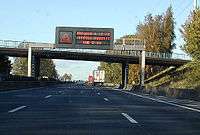
The safety measures include:
- one way driving: the lanes driving in the opposite direction are separated by at least a crash barrier, which is designed to resist the oblique impact of a car at up to 180 km/h (110 mph); no intersecting roads but bridges and tunnels;
- wider carriageways, at least 2 (often 3) lanes driving in the same direction, with a larger turning radius - some recently built autoroutes have one-lane-only sections; For private motorways, in 2017, the proportion is 6800 km (74%) in 2x2 lanes, 2252 km (25%) in 2x3 lanes, 84 km (1%) in 2x4 lanes.[2] Each lane is 3m50 wide from 2000 standard.[4]
- long acceleration and slowing lanes to get in or out of the autoroute without disturbing the traffic;
- presence of an additional emergency lane where it is forbidden to drive (except for the emergency services) and to park (except in case of emergency) and to walk;[5] Since 2000, new emergency lanes on new motorways should be 2m50 wide (or 3m00 when there are more than 2000 trucks a day). According to 2000 standard, the right of the road should contain a security zone of 8m50 or 10m wide in the limit of 3m high.[4]
- presence of emergency call boxes every 2 km (1.2 mi) on each side, that allow to call for help with the possibility to locate the call; some call boxes have flashing light that warn when there is a problem ahead;

- presence every 10 km (6.2 mi) (4–6 minutes of driving) of resting zones (aire de repos, i.e. car parks with public toilets), and every 40 km (25 mi) (20–30 minutes of driving) of a resting zone with a restaurant and a gas station - on most recently built autoroutes these distances are longer;
- regular patrols of the security services, to clear any obstacle and protect drivers in trouble (usually a breakdown or a flat tyre) with appropriate warning signs and beacons;
- dynamic information panels that warn about possible difficulties ahead (accident, people at work, traffic jam);
- an FM radio station (107.7 MHz) provides flash info every 15 minutes (sometimes following by an English report) and when it breaks;
- on heavy traffic days (e.g. beginning and end of school holidays): organisation of specific information and recreation events at rest areas;
- radars automatiques (speed cameras) currently being installed in many locations.
Safety results
Fatalities on motorways have decreased between 2002 and 2016.
| Fatalities |
|---|
 |
| Source ASFA[6] · [7] |
Fatalities accidents scenario
On French motorways, in 2016, 121 fatal accidents are direct/initial accidents representing 82% of fatal accidents, 16 (11%) fatal accidents occurs after a previous accident, and 10 (7%) fatal accidents occur after an incident.[7]
Three scenario catch two third of initial accidents:[7]
- A01 simple collision of two vehicle without direction change
- A06 crash on protection system such as safety traffic barrier
- A05 loss of vehicle control
Fatalities and accidents remaining factors
Most of fatalities occur by night.
| Fatal accident by Light condition | Fatal accident cause |
|---|---|
 |
 |
| Source Sécurité routière[8] | Source ASFA[2] |
Several factor of accidents are more highly probable by night in proportion to the traffic, although inattentiveness remains risky during the day.
| Influence of time on the risk of accident (% of accidents divided by % of traffic) | |
|---|---|
 | |
 | |
 | |
 | |
 | |
 | |
| Source ASFA[7] |
Young drivers
Young drivers between 18 and 34 years old represent 19% of motorway drivers, but they are overrepresented in fatal motor vehicle collisions[6] and are involved in more than half of fatal accidents.[6]
| Involvement of young drivers in 2016, in fatal accidents | ||||
|---|---|---|---|---|
| young drivers in dangerous manoeuvre | young drivers in inattentiveness | young drivers in excessive speeding | ||
 |
 |
 | ||
| Source ASFA[6] | ||||
Pedestrians
Although pedestrians are forbidden on motorways in conformity with the Vienna Convention, they are still sometimes killed on motorways.
In case a vehicle on a carriage cannot move, motorways safety rules remains applicable: it is forbidden for a pedestrian to travel on the motorway by article 421-2 from the "Code de la route" law. For this reason, in case of accident or breakdown, it is advised to turn on hazard warning lights, wear high-visibility clothing, and go in a safer place such as the other side from the traffic barrier where there is no traffic. Since 2008, it is clarified that warning triangles are no longer mandatory when they would endanger the driver of the disabled vehicle.[9]
| Pedestrians killed in 2016 | ||||
|---|---|---|---|---|
| Place where pedestrians are killed | Reason for pedestrian presence | |||
 |
 | |||
| Source ASFA | ||||
Economics
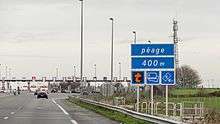
The toll roads were granted as concessions to mixed-economy corporations; the free roads are directly administered by the national government. Tolls are either based on a flat-rate for access to the road or on the distance driven. The latter case is the most common for long distances; users take a ticket from an automatic machine when they enter the autoroute, and pay according to the distance when exiting; toll booths accept multiple payment methods.

In 2005, the Villepin government proposed a controversial plan to sell all of the state's holdings in autoroute companies to private investors. Critics contend that the price announced is well below the profit forecasts for these companies, and thus that the government sacrifices the future to solve current budgetary problems.[10]
| Mode of payment | |
|---|---|
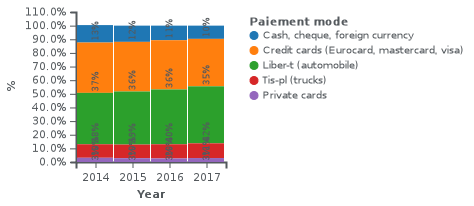 |
|
| Source ASFA[2][11] |
List of Autoroutes
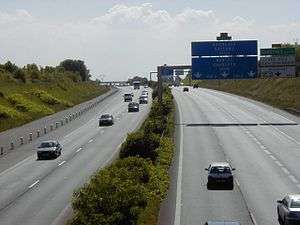
| Number | Length (km) | Length (mi) | Southern or western terminus | Northern or eastern terminus | Route name | Formed | Removed | Notes |
|---|---|---|---|---|---|---|---|---|
| 211 | 131 | Paris (Porte de la Chapelle) | Lille | Autoroute du Nord | 1954 | current | Part of E 15 / E 17 / E 19 | |
| 77.6 | 48.2 | Combles | Belgium | — | — | Part of E 19 | ||
| 18.4 | 11.4 | Paris (Porte de Bagnolet) | Gonesse | 1969 | current | Part of E 15 | ||
| 482 | 300 | Paris (Porte de Bercy) | Strasbourg | Autoroute de l'Est | 1970 | current | Part of E 25 / E 50 | |
| 225 | 140 | Vert-Saint-Denis (Seine-et-Marne) | Langres | 1983 | current | Part of E 17 / E 54 | ||
| 466.3 | 289.7 | Lyon | Paris | Autoroute du Sud Autoroute du Soleil |
1960 | current | Part of E 15 / E 21 / E 60 | |
| 312 | 194 | Marseille | Lyon | Autoroute du Soleil | 1951 | current | Part of E 15 / E 80 / E 714 | |
| 224 | 139 | La Fare-les-Oliviers | Italy | La Provençale | 1961 | current | Part of E 74 / E 80 | |
| 280 | 174 | Spain | Orange | La Languedocienne La Catalane |
1960 | current | Part of E 15 / E 80 | |
| 557 | 346 | Bordeaux | Rungis | L'Aquitaine | 1960 | current | Part of E 5 | |
| 347 | 216 | Nantes | Ponthévrard | L'Océane | 1966 | current | Part of E 50 / E 60 / E 501 | |
| 8.5 | 5.3 | Trappes | Rocquencourt | Autoroute de Bretagne | 1950 | current | ||
| 226 | 140 | Caen (Porte de Paris) | Paris (Porte d'Auteuil) | Autoroute de Normandie | 1940 | current | Part of E 5 / E 46 | |
| 21.7 | 13.5 | La Défense | Orgeval | 1996 | current | |||
| 24 | 15 | Gennevilliers | Cergy | 1974 | current | |||
| 319 | 198 | L'Isle-Adam | Belgium | L'Européenne | 1991 | current | Part of E 40 / E 44 / E 401 / E 402 | |
| 131 | 81 | Orléans (A10 at Artenay) | Sens | L'Éco Autoroute | 1993 | current | Part of E 511 | |
| 428 | 266 | Montauban | Vierzon | L'Occitane | 1992 | current | Part of E 9 | |
| 58.9 | 36.6 | Aix-Noulette | Douchy-les-Mines | Rocade Minière | 1971 | current | ||
| 15.8 | 9.8 | Villeneuve-d'Ascq | Belgium | Autoroute du Nord | 1972 | current | Part of E 17 | |
| 42.7 | 26.5 | Lesquin | Trith-Saint-Léger | 1978 | current | |||
| — | — | Amiens | Belgium | 1980 | 2011 | Proposed, but never built | ||
| 62.7 | 39.0 | Lesquin | Dunkirk | 1963 | current | Part of E 42 | ||
| 395 | 245 | Troyes | Calais | Autoroute des Anglais | 1976 | current | Part of E 15 / E 17 / E 50 | |
| 13.7 | 8.5 | Lesquin | Belgium | 1973 | current | Part of E 42 | ||
| 366.5 | 227.7 | Abbeville | Tours | Autoroute des Estuaires | 2005 | current | Part of E 44 / E 402 / E 502 | |
| 183 | 114 | Le Havre | Saint-Quentin | 1995 | current | Part of E 44 / E 402 |
A30 - A39
- A 30 : Uckange - Crusnes
- A 31 : Beaune - Luxembourg
- A 32 : Freyming-Merlebach - Germany
- A 33 : Nancy - Hudiviller (local autoroute around Nancy)
- A 34 : Reims - Charleville-Mézières - Belgium
- A 35 : Lauterbourg - Switzerland (Basel)
- A 36 La Comtoise : (A 31) Ladoix-Serrigny - Germany
- A 38 : Pouilly-en-Auxois - Dijon
- A 39 Autoroute Verte : Dijon - Bourg-en-Bresse
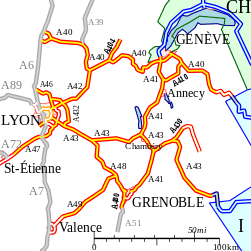
A40 - A49
- A40 E62 Autoroute Blanche, Autoroute des Titans : Mâcon - Mont Blanc Tunnel
- A41 : Switzerland (Geneva) - Grenoble
- A42 E611 : Lyon - Bourg-en-Bresse
- A43 : Lyon - Italy
- A44 : (project) bypassing Lyon by west
- A45 : Lyon - Saint-Étienne
- A46 : Anse - Givors (bypassing Lyon by east)
- A47 E70 : Lyon - Saint-Étienne
- A48 : Lyon - Grenoble
- A49 : Grenoble - Valence
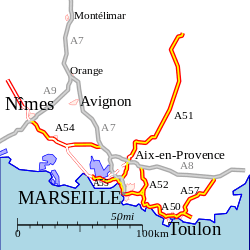
A50 - A59
- A50 : Marseille - Toulon
- A507/L2 : (under construction, planned since 1935) ring of Marseilles.
- A500 : access to Monaco
- A51 : Marseille - Grenoble, Val de Durance
- A516 : Autoroute link between A51 from Marseilles and the city center of Aix-en-Provence
- A52 : Autoroute link between A8 and A50, great ring of Marseilles.
- A520 : Autoroute link between A52 and Auriol, access to Saint Maximin via the Sambuc pass
- A54 : Nîmes - Salon Sud (link with A7)
- A55 : (Nîmes) - Martigues - Marseille
- A557 : one-direction ring of Marseilles downtown
- A56 : (under construction), link between A54 and A55 from Salon to Fos freight port
- A57 : Toulon – Vidauban, link with A8
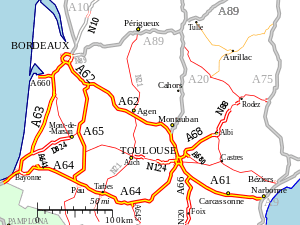
A60 - A69
A70 - A79
- A71 : L'Arverne Orléans (A10) - Clermont-Ferrand (A75)
- A72 : Saint-Étienne - Clermont-Ferrand
- A75 La Méridienne : Clermont-Ferrand - Béziers (A0)
- A77 Autoroute de l'Arbre Poligny (A6) - Nevers - Challuy
A80 - A89
| Number | Length (km) | Length (mi) | Southern or western terminus | Northern or eastern terminus | Route name | Formed | Removed | Notes |
|---|---|---|---|---|---|---|---|---|
| 94.8 | 58.9 | Le Mans | Le Gravelle | 1982 | current | |||
| 152.5 | 94.8 | Nantes | Niort | 2001 | current | |||
| 170.5 | 105.9 | Caen (Porte de Bretagne) | Rennes | Autoroute des Estuaires | 2003 | current | Part of E 3 / E 46 / E 401 | |
| 270 | 168 | Angers | Vierzon | 1997 | current | |||
| 80.1 | 49.8 | Paris orbital | Paris orbital | 2009 | current | |||
| 129 | 80 | Angers | La Roche-sur-Yon | 2002 | current | |||
| 117.7 | 73.1 | Caen (Porte d'Espagne) | Sees | 2010 | current | |||
| 544 | 338 | Lyon | Bordeaux | 1991 | current | Part of E 70 |
Others
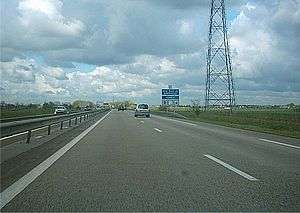
- A1(972) : Around Fort-de-France. Autoroute in Martinique, a French overseas territory.
- A104 : The Francilienne around the Île-de-France (Paris) region
- A105 : Combs-la-Ville
- A110 : Ablis - Tours (proposed)
- A115 : A15 (Sannois) - Méry-sur-Oise
- A131 : Bourneville (A13 exit 26) - Le Havre
- A132 : A13 / Pont-L'Évêque - Canapville
- A154 : A13 - Louviers
- A199 : Torcy - Champs-sur-Marne (downgraded into RD 199)
- A203 : Charleville-Mézières - Glaire
- A211 : A21 - N17
- A216 : A16/A26 - N216 Calais
- A260 : Boulogne-sur-Mer - A26
- A320 : A4 - Germany
- A330 : Nancy - Richardménil
- A391 : A39 - RN83
- A404 : Saint-Martin-du-Frêne - Oyonnax - Arbent
- A406 : Mâcon
- A430 : Chamousset - Gilly-sur-Isère
- A432 : Saint-Laurent-de-Mure - Montluel
- A508 : Tunnel (access to Monaco)
- A570 : A57 - Hyères
- A620 : A61 - A62 ( West ring of Toulouse)
- A621 : Toulouse - Blagnac
- A623 : A620 - A61
- A624 : Toulouse - Colomiers
- A630 : Lormont - Bègles
- A631 : Bègles
- A641 : Oeyregave - Orthevielle
- A645 : Ponlat-Taillebourg - Seilhan
- A660 : Mios - Gujan-Mestras
- A680 : Castelmaurou - Verfeil
- A710 : Gerzat - Clermont-Ferrand
- A711 : Lempdes - Pont-du-Château
- A712 : Lempdes - Pont-du-Château
- A714 : Bizeneuille - Saint-Victor
- A719 : Gannat - Monteignet-sur-l'Andelot
- A750 : A75 to Clermont-l'Hérault - Montpellier
- A810 : La Rochelle - A10
- A811 : Carquefou - Sainte-Luce-sur-Loire
- A813 :Banneville-la-Campagne-Frénouville
- A831 : Rochefort - La Rochelle - Fontenay-le-Comte
- A837 Autoroute des Oiseaux : Rochefort - Écurat (A10)
- A844 : A11-A82
Radio coverage
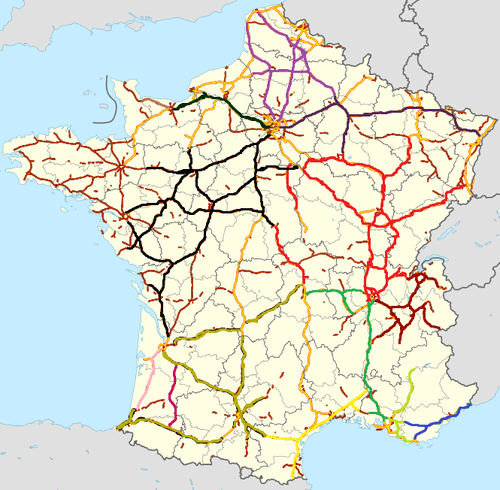
The FM 107.7 radio coverage is available in 2017 on 8902 kilometres of the (ASFA) network.[12]. This is list of highways that are updated in 107.7 FM every 15 minutes, live 24/7 (if the highway is said alone, it means that the station covers all around it):
Sanef 107.7 (1850km)
- Nord
- A1 : Roissy-en-France - Carvin
- A2 : A1 - Hordain
- A16 : L'Isle-d'Adam - Boulogne-sur-Mer
- A26 : Calais - Saint-Quentin
- A29 : Neufchâtel-en-Bray - Saint-Quentin
- Est
- Ouest
Autoroute INFO (2487km)
- Centre-Est (live from Dijon)
- A5 : Lieusant - Langres
- A6 : Fleury-en-Bière - Limonest
- A19 : Courtenay - Sens
- A26 : northern Troyes - southern Troyes
- A31 : Beaune - Toul
- A36 : Beaune - Mulhouse
- A39 : Dijon - Bourg-en-Bresse
- A40 : Mâcon - Bellegarde
- A46 : Anse - Vaulx-en-Velin
- A71 : Bourges - Clermont-Ferrand
- A77 : A6 - Cosne-Cours-sur-Loire
- A105
- A311
- A391
- A406
- A411
- A430
- A714
- Rhône-Alpes (live from Chambéry)
Environment
99% of the privately managed network is protected by natural fencing.[13]
Privately managed motorways have 1764 wildlife crossing structures.[14]
See also
References
- Bilan de l'accidentalité de l'année 2015
- http://www.autoroutes.fr/FCKeditor/UserFiles/File/ASFA_cles17.pdf
- http://www.autoroutes.fr/FCKeditor/UserFiles/File/ASFA_Chiffres_Cles18%282%29.pdf
- http://dtrf.setra.fr/pdf/pj/Dtrf/0002/Dtrf-0002540/DT2540.pdf?openerPage=notice
- by definition motorways are forbidden to pedestrian
- http://www.autoroutes.fr/FCKeditor/UserFiles/File/Chiffres%20cl%C3%A9s%20accidents%20mortels%202016.pdf
- http://www.autoroutes.fr/FCKeditor/UserFiles/File/Analyse%20des%20accidents%20mortels%20et%20corporels%202016%201.pdf
- http://www.securite-routiere.gouv.fr/la-securite-routiere/l-observatoire-national-interministeriel-de-la-securite-routiere/accidentalite-routiere/bilans-annuels
- https://www.economie.gouv.fr/dgccrf/Publications/Vie-pratique/Fiches-pratiques/Triangles-de-pre-signalisation-gilets-de-securite
- Press release of 12-14-2005 Archived November 20, 2006, at the Wayback Machine
- http://www.autoroutes.fr/FCKeditor/UserFiles/File/ASFA_Chiffres_Cles18%282%29.pdf
- http://www.autoroutes.fr/FCKeditor/UserFiles/File/ASFA_Chiffres_Cles18%282%29.pdf
- http://www.autoroutes.fr/FCKeditor/UserFiles/File/ASFA_Chiffres_Cles18%282%29.pdf
- http://www.autoroutes.fr/FCKeditor/UserFiles/File/ASFA_Chiffres_Cles18%282%29.pdf
External links
| Wikimedia Commons has media related to Autoroutes in France. |
